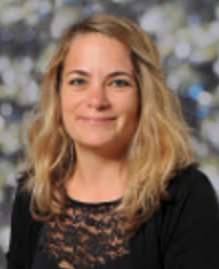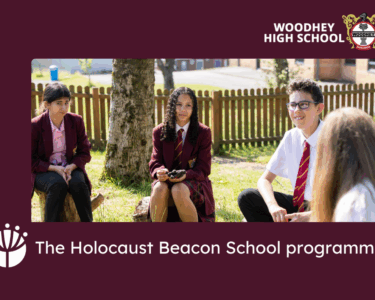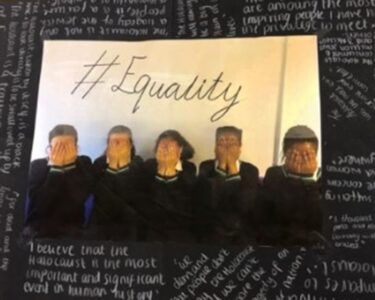Guest blog by Vanessa Favali, St Laurence School
‘For many people the phrase ‘dark tourism’ is uncomfortable. But it’s not the dark part necessarily, it’s the idea that sites of death could be a form of tourism. The word ‘tourist’ immediately conjures up stereotypes of crowds of people with their cameras following guides, being herded around passively absorbing the information presented to them. When you then pair that image with sites of/associated with death it seems voyeuristic, potentially even offensive. This immediately changes when you consider these sites are being visited to commemorate or memorialise the victims or as part of an educational trip. It becomes more palatable because you are going to learn, to remember, to have some kind deeper experiential encounter with the site. Since 2015, I’ve taken around 60 students to Krakow, Poland to visit sites of the Holocaust, including Płaszów concentration camp and the Auschwitz – Birkenau State Museum (ABSM). Never once, until recently however, did it occur to me that we were engaging in dark tourism. The more I’ve investigated this phenomenon, through my own post graduate studies and research, the more I have come to release I needed to ‘rethink’ my concepts of tourism, specifically in the context of Holocaust education and how I use educational trips to such sites.
The phrase dark tourism was coined by Lennon and Foely in 1996[1], as “incidences of death, disaster and atrocity that have taken place within living memory”. Stone (2006)[2] suggests a fluid spectrum of darkness to help understand and categorise types of dark tourist sites ranging from the lightest sites, those associated with death, often but not exclusively with an entertainment element like the London Dungeons, through to the darkest sites, those of death and suffering, such as the ABSM. It’s certainly not a new phenomenon, people have been visiting sites of death for centuries for a wide range of reasons. Sociologists and much of the research into tourism suggests that this desire to travel to unusual places, those ‘off the beaten track’ so to speak, including dark tourist sites, has been in response to wanting to have ‘authentic’ experiences/encounters. We are on a quest for what Wang (1999)[3] and others call existential authenticity, an authentic sense of being, focussing on emotions, sensations, and relationships. This is true in the context of dark tourism, including sites of the Holocaust[4]. In fact, arguably, one of the key pedagogical benefits of including these sites in Holocaust education is their existential authenticity. The use of in-situ sites in Holocaust education is supported by research which suggest it offers students a unique tangible opportunity to connect with the victims and this difficult, complex history, in ways that are not necessarily achievable in a classroom. Students (and educators) want and even expect to have a transformative encounter with the site. Crucially however, as educators we must help students avoid the misconception that because they have visited in-situ sites, like the camps, they have experienced what the victims did. We also need avoid choosing specific sites just purely to elicit an emotional response from our students. How then do we facilitate this encounter without compromising the wellbeing of our students and just as importantly not exploiting the victims or causing misconceptions?
I’m by no means an expert, but through examining the theoretical and practical issues of dark tourism in Holocaust education the answer, partially at least, is in a carefully constructed itinerary. With increasing time demands on teachers, using a pre-packaged trip through a tour operator saves precious time. Whilst tour operators will have expertise in organising group travel, they don’t necessary understand the challenges involved in visiting these as ‘dark tourist’ sites. On our first visit to the ABSM with students, we did the standard three-hour tour with the official museum tour guide, going into exhibitions such as those of the victim’s belongings and hair. These are incredibly difficult to encounter, even as an adult, but there was little, if any time for reflection. It was on to the next room, following the masses of people also on tours, through the one-way flowing traffic from room to room making sure we didn’t get left behind or cause a backlog. We now explicitly build in time for our students to reflect and process what they have seen and felt, or equally not felt, after visiting the site, making sure that on the day we visit the ABSM we do nothing else. Careful attention is paid to each element of the trip, not just the in-situ sites and museums visited, but also the walking tour of Krakow city, and even choosing tour guides from places such as Płaszów concentration camp. These decisions are based on the nature of the site itself but also in terms of its pedagogical value in understanding the context of the Holocaust in Krakow, both past and present. Controversially, perhaps, I find myself increasingly questioning whether ‘effective’ Holocaust education must even include visits to the darkest of Holocaust sites, such as camps.
Understanding how dark tourist sites are being used in Holocaust education continues to be important as we begin to navigate the increased use of digital and virtual technology in the post-COVID pandemic era, where again concepts of ‘tourism’ will need rethinking. Dark tourism will always be a controversial and contested term, specifically in the context of Holocaust education. However, re-framing or accepting such educational trips as a sub-genre of dark tourism can subsequently improve Holocaust teaching. I’ve made my peace with the idea that I am indeed a dark tourist.’
Vanessa Favali teaches Sociology and RE at St Laurence School and is a Beacon School 2022-23 Lead Teacher

[1] Lennon, J. and Foley, M. (2010), Dark Tourism the Attraction of Death and Disaster. Andover: Cengage Learning EMEA.
[2] Sharpley, R. (2009), ‘Shedding Light on Dark Tourism: An introduction’ in Sharpley and Stone (eds.), The Darker Side of Travel the Theory and Practice of Dark Tourism. Bristol: Channel View Publication, 3-22.
[3] Wang, N. (1999) ‘Rethinking Authenticity in Tourism Experience’. Annals of Tourism Research, 26 (2), 349-370.
[4] N.B. Concepts of authenticity, specifically at dark tourist sites are still widely debated in academic research, as is the idea that Holocaust sites should be considered a sub-genre of dark tourism.



